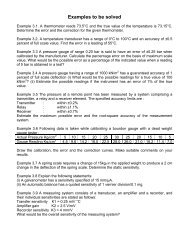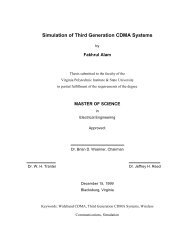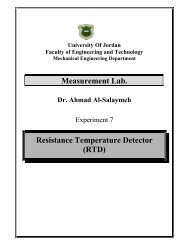Communications I Dr. Mohammed Hawa Introduction to Digital - FET
Communications I Dr. Mohammed Hawa Introduction to Digital - FET
Communications I Dr. Mohammed Hawa Introduction to Digital - FET
Create successful ePaper yourself
Turn your PDF publications into a flip-book with our unique Google optimized e-Paper software.
6. <strong>Digital</strong> communication is inherently more efficient than analog systems inexchanging SNR for bandwidth, and allows such exchange at both the basebandand carrier levels.7. <strong>Digital</strong> hardware implementation is flexible and permits the use ofmicroprocessors. Using microprocessors <strong>to</strong> perform digital signal processing (DSP)eliminates the need <strong>to</strong> build expensive and bulky discrete-component devices. Inaddition, the price of microprocessors continues <strong>to</strong> drop every day.8. <strong>Digital</strong> signal s<strong>to</strong>rage is relatively easy and inexpensive. Also the reproduction ofdigital messages can be extremely reliable without deterioration, unlike analogsignals.Actually, due <strong>to</strong> those important advantages most of communication systemsnowadays are digital, with analog communication playing a minor role (we still, forexample, listen <strong>to</strong> analog AM and FM radio).This article provides a very quick overview of some of the main concepts that arerelevant <strong>to</strong> digital baseband transmission. You will study more about this <strong>to</strong>pic in theEE422 “<strong>Communications</strong> II” course. The main concepts <strong>to</strong> be emphasized here willbe the analog-<strong>to</strong>-digital conversion process and the line coding concept.Digitization (and Analog-<strong>to</strong>-<strong>Digital</strong> (A/D) Conversion):Signals that result from physical phenomena (such as voice or video) are almostalways analog baseband signals. Converting such analog baseband signals in<strong>to</strong> digitalbaseband signals is not as simple as one might expect, especially when consideringmodern communication systems such as <strong>Digital</strong> TV, SDH, Ethernet, ADSL, etc. Tosummarize, we say digitization involves the following steps:1. Sampling (in which the signal becomes a sampled analog signal, also called adiscrete analog signal).2. Quantization (the signal becomes a quantized discrete signal, but not a digitalbaseband signal yet).3. Mapping (the signal becomes a stream of 1‟s and 0‟s). Mapping is sometimesconfusingly called encoding.4. Encoding and Pulse Shaping (after which the signal becomes a digital basebandsignal).These four steps are shown in Figure 2 below and are explained in the followingsubsections.AnalogBasebandSignalA/D1's & 0'sEncoding &Pulse Shaping<strong>Digital</strong>BasebandSignal<strong>Digital</strong>Modulation<strong>Digital</strong>CarrierSignalSampling Quantization MappingSourceEncodingChannelEncodingLineEncodingPulseShaping(Optional) (Optional) (Manda<strong>to</strong>ry) (Manda<strong>to</strong>ry)Figure 2. The Many Steps of Digitization.2
















